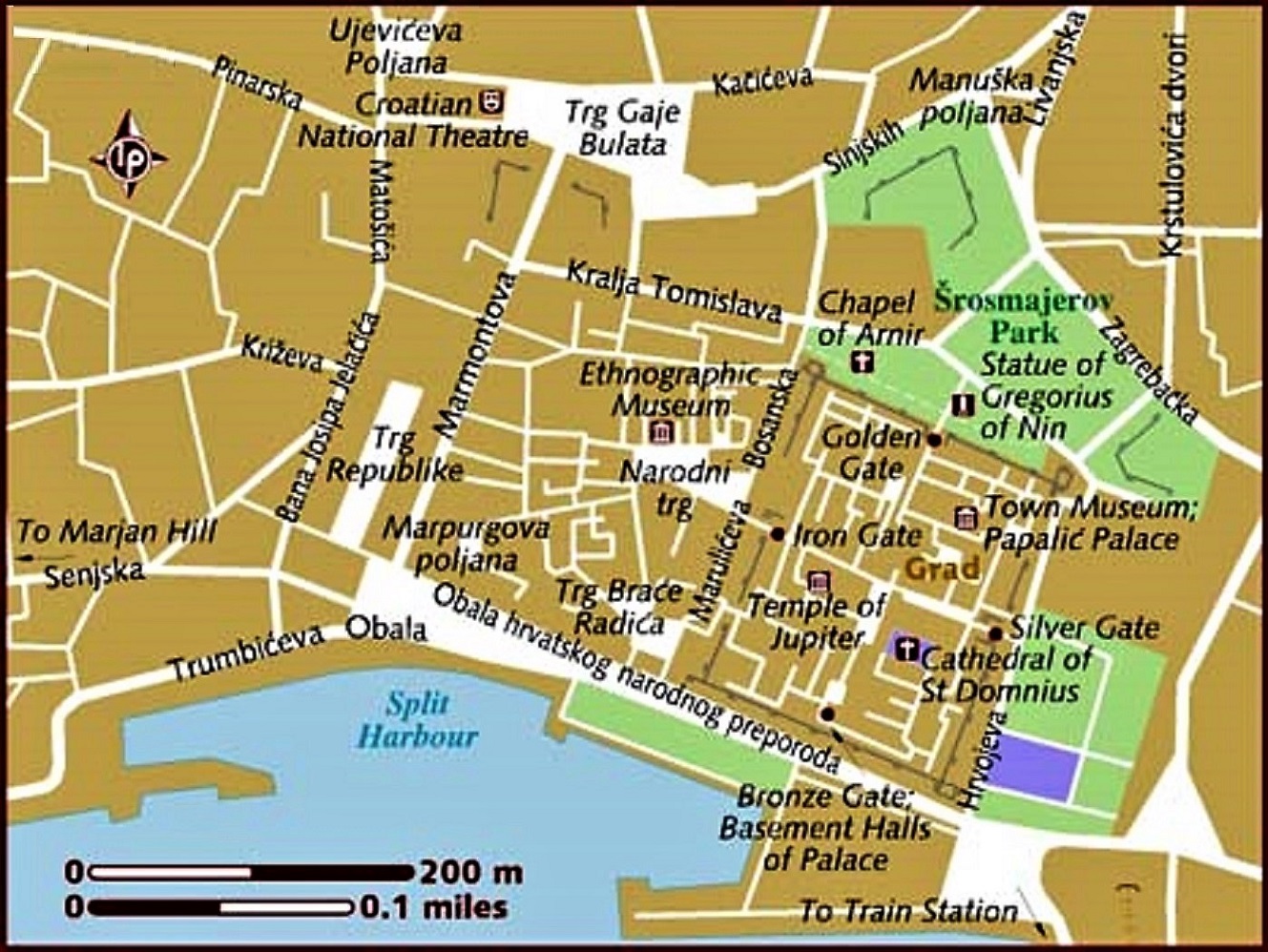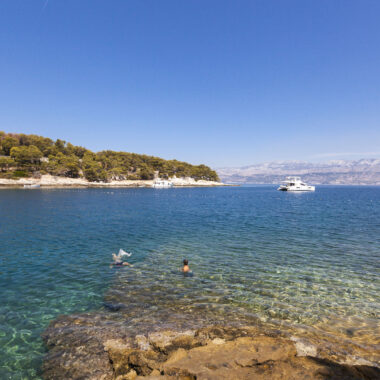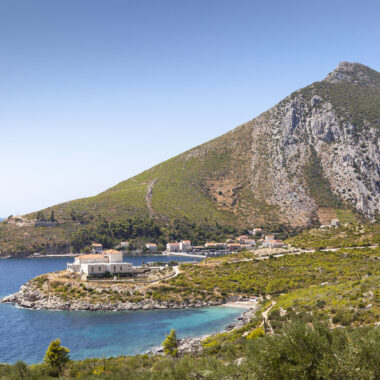As we were walking to the train station in Bassano del Grappa headed for the ferry port in Ancona my phone buzzed asking me if I’d made a purchase of $478 at a website in Africa. I of course had not, and so my primary credit card was immediately canceled. The day wasn’t starting well. Our trip to Ancona halfway down the eastern shore of Italy took us on three trains, to Venice, Bologna and finally Ancona. We’d allowed an hour grace time in Ancona between when our train arrived and check-in for the ferry to Croatia, we thought that was plenty of time given the trains in Italy typically run like clockwork. But as we sat in Bologna for five, 15, 30 and eventually 37 minutes past the time the train was due to leave Lisa and I started to get a little nervous. Long story short: we made it to check-in with time to spare and only got mildly fleeced by the taxi driver who took us to the port. He well and truly knew the time crunch we were under.
The MV Moby Corse was a behemoth of a ship, eight floors of cabins and a belly that made the car deck on the MV Matanuska from our Inside Passage journey look like a bathtub toy. It was more like a cruise ship than a ferry, with onboard pizza parlor, full service bar and a few restaurants (one with a grand piano!). Our four berth cabin on the eighth deck was quite spacious with bunks the kids loved, a great way to make the 11 hour journey across the Adriatic Sea from Italy to Croatia. It would have been possible for us to continue on our Eurail passes from Bassano del Grappa to Split in Croatia, but it was more than 12 hours of rail time which did not seem at all appetizing. The high-speed train to Ancona only took us a few hours, and the bulk of our time on the MV Moby Corse was spent asleep so it doubled as a night of accommodation for us all. Note to self: take beer on an SNAV ferry if I ever catch one again, as the beer prices onboard were the most expensive we’d seen anywhere in Europe.
Split is a base for accessing the islands of central Croatia, as well as the inland national parks with all those turquoise waterfalls I’m sure anyone with an Instagram app has seen on their feed (Plitvice Lakes and Krka National Park are the most famous). The city is also home to the palace of Roman Emperor Diocletian, a sprawling maze of passageways and courtyards built in AD 305 to be not just his home but also a military fortress. After Diocletian died, the fortress continued to be a retreat for Roman rulers before being abandoned for centuries. In the twelfth to fourteenth centuries it became an ecclesiastical center, and later a fort. Finally, in the late eighteenth and early nineteenth centuries it was an Austrian outpost.
Not only is it one of the most impressive Roman ruins in the world, but it’s also unique because it’s still inhabited by people and is effectively the center of modern day Split. Most of Diocletian’s Palace can be explored on foot just by walking through Split’s old town, as they’re one in the same. There were a few areas of the palace that required tickets – like the Temple of Jupiter – but for the most part we were able to traverse the centuries-old fortress on foot at our own pace. Diocletian’s Palace was also quite the treat for Lisa and I – we’re both Game of Thrones junkies – as it was the filming location for a lot of the scenes of Daenerys Targaryen’s homeland in the early seasons. The photos of the substructure of Diocletian’s Palace below was where the scenes ofDaenerys’ dragons were filmed when they were shackled. It was impossible not to feel like we were traveling back in time whilst exploring the narrow alleyways of the palace, especially the towering Golden Gate area on the palace’s northern wall. Diocletian’s Palace definitely deserves its spot on UNESCO’s World Heritage List.

When we arrived in Split from Italy, our ferry landed at 7AM so we had some time to kill on our first day in town before we were able to check into our apartment. We shoved our bags in some storage lockers in the train station across from Split’s port and strolled through the old town, grabbing some breakfast at scrumptious Kruščić Bakery and (literally) sniffing out the old town’s central fish market next door. We’d read about excellent seafood in Croatia, the offerings at the fish market were mouthwatering, Max’s mental cogs were going wild with all the possibilities!
There’s no better way to kill time in Croatia than in the ocean, we setup shop on our first morning at the Jadran Beach Bar a short walk west of the old town. The kids were in heaven in the crystal clear water of the Adriatic Sea and Lisa and I were quite content to be waited on with cold beers (it was only 10AM but it was also Saturday…) and cappuccinos.
Split is known for it’s party atmosphere, on the nights we ventured into the old town the beats of nightclubs were audible above the hum of the promenade and throngs of scantily clad 20-somethings were out in force. We stayed at a great apartment outside of the old town, still close enough (a 20 minute walk) to stroll into the palace and also 10-15 minutes by foot from a handful of Split’s beaches. The cuisine in Croatia was fun to explore, the kids loved the ćevapčići fast food stalls dotted throughout the city (I can remember downing them at their age too). Everyone voted the offerings from Kantun Paulina in the old town as the bestćevapčići in Split, the kids went through 20 sausages between them at one lunch sitting! The Kantun Paulina piletina were incredibly good as well: fresh-baked lepinja sandwiching chicken fillet with vegetables, a tomato- and pepper-based chutney, and a cream cheese that was almost like butter. Divine! We also very much enjoyed a dinner at an authentic Croatian restaurant called Fife on the western edge of Diocletian’s Palace: cuttlefish risotto with squid ink, a Croatian-styled pot roast with gravy and homemade gnocchi, traditional Dalmatian fish soup and local fried calamari. Some exceptional food. Oh, and the bureks, I think Lilia would have subsisted entirely on cheese bureks if we’d let her: crispy pastry filled with a mild, salty cheese that were available for pretty much every corner store and bakery dotted about the city. A few we nabbed in the mornings were still warm from the oven. Otherworldly.
We spent a lot of time at the beaches in and around Split, most of them accessible within reasonable walking distance from our apartment east of Diocletian’s Palace. The walks usually passed quickly as we hunted for ripe fruit to snack on from the fig trees that grow all over the neighborhoods of Split. We also enjoyed a very fun day on the beach in Brač, a short ferry ride from Split’s central harbor. Outside of the old town, Split was a bit rough and tumble with utilitarian-style apartment buildings dotting the city and lots of remnants of the former Yugoslavian republics’ checkered political history. Croatia’s not a rich nation, with a GDP per capita only a little more than half of neighboring Italy. That said, the pride Croatians take in their coastline was quite evident during our stay: the water of the Adriatic Sea was incredibly clear and beaches so clean. Each day during my morning run, city workers were out tidying the beaches and making sure all the esplanades were clear of trash ready for the day’s bathers. We explored quite a few of the beaches on foot, the kids voting Kupalište Ovčice as their number one: great snorkeling a short distance from the shore and some excellent rocks to boost off into the ocean. As with Italy, most of the beaches were accompanied by cafes and bars, serving basic snacks and everything from coffee to cocktails (at less than half the price of Italy…). Unlike Italy, however, all beaches in Croatia were free to the public, it was so nice not to have to cram into small strips of public beach like we had to in so many parts of Italy. Max could have passed as a tourist from Italy with his head-to-toe bronze skin after all the time in the sun!
After our day on Brač and our realization at Pub Beer Garden that there’s quite the craft beer scene in Croatia, we ventured east of our apartment in Split to sample the goods at Tap B craft brewery. The brewery and tasting room were situated at the base of some of Split’s utilitarian apartment towers – I thought we’d gotten ourselves lost at first – with outdoor seating overlooking the Adriatic Sea amidst suburban rubble and partially finished construction. The young bartender was a welcoming chap, chatting to us in perfect English about the beers. Lisa is usually a big fan of stouts but wasn’t too plussed with Tap B’s offering. I did, however, very much enjoy their American pale ale. The Italian, French and Croatian lagers are all excellent in the heat of summer, but it was very nice to have a few brews with a little more meat on them.
Split was a fantastic introduction to the Balkans, such great beaches in the central part of the city and so much history to absorb in Diocletian’s Palace. Our day in Brač was a memorable highlight for everyone in the family, so easy to explore the islands on the state-owned ferries that run out of Split. We’re all looking forward to more of Croatia’s beaches further south at our next stop in Dubrovnik!











































































































































Pingback: Dubrovnik – Our Walkabout Two
Pingback: Brač – Our Walkabout Two
Pingback: Vis – Our Walkabout Two
LOVE that cruise ship, fantastic fish markets, glorious swimming waters, ancient cities … what an adventure that keeps on blessing!
Your Family Q
Looks like you are having ideal weather. Now that it is September, and the Euros have to return to work, perhaps things will be less crowded? No smoke from the wildfires in Greece?
Croatia hasn’t actually been that crowded, but Italy was pretty jammed, yes. We had a little smoke from the wildfires in Greece when we were on the Amalfi Coast and then on our first day in Split, but for the past couple of weeks the skies have been clear.
Pingback: Plitvice National Park – Our Walkabout Two